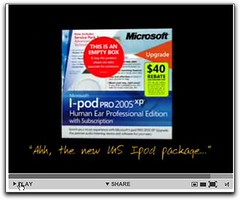Link to: e-Literate: Video Literacy

I’ve been thinking a lot lately about how to use rich media in courses that traditionally have been print oriented. My own background in media–both audio and video–is pretty weak, so I don’t have much of the grammar and vocabulary to think as effectively about the possibilities as I might.
Michael Feldstein’s post on Video Literacy was very helpful in helping expand my conceptual frame. He uses a video from YouTube and suggests:
… while you are watching it, imagine that it is a student-submitted video compare/contrast assignment. “Describe the differences between how Microsoft and Apple present the value of their products and their respective relationships to consumers of their products.
The analysis of the video takes it beyond the typical “Apple Cool” – “Microsoft Bad” rant by offering some perspective on why the video works on a teaching and learning level.
“What moves,” really, is that thought process. Video is a fantastic medium for expressing temporal progression. And interestingly, the narrative is constructive rather than deconstructive in nature. Academic writing tends to encourage students to take things apart but doesn’t show them how to put them back together again. The creator of this video, in contrast, had to dissect the differences between Apple’s and Microsoft’s marketing and then wrap the Microsoft marketing mindset around an existing Apple product. That shows real mastery. The student is effectively teaching the viewer how to brand like Microsoft, rather than just describing the elements that Microsoft uses on existing products.
I hope others in the blogosphere can post similar concrete examples that can help illustrate how rich media assignments expand the learning options available to us.
Yes. Getting access to the process-of-mind, for both student and teacher, means we have a much better chance of accessing and using the zone of proximal development. This, to me, means getting access to the bootstrapping process Doug Engelbart describes, in which we improve the processes of our own improvement. Elsewhere I’ve called this “gaining access to the traces of our own engagement.” As those traces persist, and we are able to reflect upon them, we can become more expert learners in all sorts of contexts.
This talk about process has me thinking in another direction as well. What does video bring to the gestalt moment, the all-at-once “a ha” moment? It’s one of the paradoxes of temporal media, especially multimedia, that they can enable such gestalt perception. Perhaps it’s because multimedia involve more of the sensorium, give us more chances to have our gift for sensing and intuiting environments to come into play. I find this to be true on occasion in film studies.